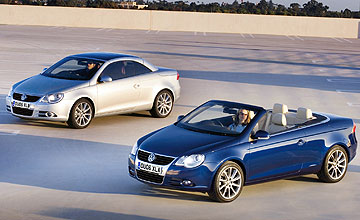BY CHRIS HARRIS | 5th Mar 2007

Priced keenly from $47,990 for the TDI turbo-diesel and $49,990 for the TFSI turbo-petrol (VW’s famed six-speed Direct Shift Gearbox costs an extra $2300 for both variants), the all-new Eos features a five-piece folding steel roof that comprises a world-first tilting/sliding glass sunroof.
Volkswagen dubs the revolutionary new hard-top system the CSC (for "convertible, sliding coupe") roof – a mechanism that is produced by Webasto and delivered just-in-time to the company’s Palmela plant in Portugal, where Eos is manufactured alongside the Sharan and Seat Alhambra.
Of course, Eos follows a long line of drop-top Volkswagens, beginning with the first Beetle Cabriolet of 1949 and including the Karmann Ghia (1955), the first Golf Cabriolet (1979), the Golf III Cab (1993), the Golf IV Cab (1998) and the New Beetle Cabriolet, which replaced the topless Golf here from 2003.
However, the CSC roof also VW join the burgeoning coupe-convertible ranks, all of which claim to offer year-round motoring pleasure by doubling as both a four-seater cabriolet for dry days and a coupe for rainy days.
With a sub-$48,000starting price for the TDI, the Eos is priced almost $20,000 lower than Australia’s only other turbo-diesel cabriolet – Saab’s new 9-3 1.9 TiD Linear Convertible, which offers a soft-top roof.
Borrowed from Golf, the Eos TDI’s 2.0-litre oil-burning engine delivers 7kW less power than the Saab with 103kW at 4000rpm, and the same torque: 320Nm from 1750rpm.
According to VW, Eos TDI is more frugal (6.0L/100km combined versus 6.3L/100km for the Saab in six-speed manual guise and 6.9L/100km in DSG form versus 7.1L/100km in six-speed auto form). Eos TDI is also claimed to be quicker to 100km/h than the roofless 9-3 diesel, completing the dash in 10.3 seconds in both manual and DSG guises (Saab: 10.4 manual/11.8 auto).
The Eos TDI also comes well equipped as standard, offering extras over the 9-3 like 17-inch alloy wheels, rear parking sensors, a six-CD stacker, an auto-dimming interior mirror and tyre pressure monitor.
Other standard Eos features include twin front and twin front side/head airbags, stability and traction control, ABS, dual-zone climate-control, an eight-speaker sound system, rain-sensing wipers, automatic headlights, cruise control, trip computer, a multi-function leather steering wheel, power windows/mirrors, LED tail-lights, black cloth trim and foglights.
At $49,990, the 147kW/280Nm Eos TFSI manual also offers more power and torque than its three key rivals in Peugeot’s 103kW/200Nm 307 CC 2.0 Dynamic ($47,990), Renault’s 98kW/191Nm Megane CC 2.0 Dynamic ($48,990) and Holden’s 110kW/210Nm Astra TwinTop 2.2 ($45,490) – all of which come with optional four-speed autos.
While Ford’s forthcoming Focus CC will also be a direct Eos rival, Volkswagen lists the Saab 9-3 2.0T ($64,900), Volvo’s new C70 2.4 LE coupe-convertible ($69,950), Mazda’s MX-5 Hardtop Coupe, Audi’s TT, the Mercedes-Benz CLK Cabrio, Audi’s A4 Convertible and BMW’s upcoming 3 Series Convertible as secondary Eos competitors.
Eos resides on a new platform, dubbed PQ45, which employs the Golf and Jetta’s MacPherson strut suspension up front and the Passat’s multi-link IRS with aluminium hub carriers – and which could form the basis for Audi’s next-generation A4 model range. A second-generation electro-mechanical steering system is fitted.
Eos measures 1790mm wide, 4410mm long and 1440mm metres high, and has a wheelbase of 2580mm – midway between Jetta and Passat.
It borrows design cues from both the Passat and Golf, with a Passat-like chrome grille and large headlights and Golf-like interior trim. At the rear the Eos has a near-flat bootlid deck, which melds seamlessly with the coupe-like roof profile.
The sophisticated Eos roof incorporates a unique sliding and tilting glass section that offers the practicality of a sunroof with unimpeded year-round visibility – a first for a convertible and one better than the Megane’s fixed glass roof. Even in bad weather, the interior is bright thanks to the sliding/tilting glass roof, while a blind protects its occupants.
The roof’s hard shell makes life harder for thieves, while the sunroof slides backwards or can also be opened upwards 35mm. When open, a manually operated wind deflector reduces cabin buffeting, while a pricey, optional wind blocker aims to do the same with the roof down – but cannot be used when the rear seats are occupied.
The electric roof itself can be opened and closed in 25 seconds (which isn’t as quick as the new 3 Series Convertible’s folding roof system) and, unlike some rivals, the windscreen header frame does not impede front seat headroom. It cannot be operated on the move, however.
The CSC roof comprises 470 different components and its mechanicals weigh just 22kg. With the roof down the boot offers 205 litres of luggage space when the roof is up space is 380 litres. The boot also closes via a powered latching system as standard and a space-saver spare wheel is fitted.
Load capacity is aided by a lockable load-through facility while a hard shell luggage compartment cover in the boot protects contents as well as the roof from damage. The TFSI brakes are larger than the TDI’s and a Boot Lid Assistant warns of possible obstacles in the roof mechanism’s path.
Apart from the sophisticated roof mechanism, VW has concentrated on delivering an extremely rigid car via high strength steel, strengthened A-pillars and floor panels as well as special railing inside the doors.
Rounding out the standard safety equipment list is an automatic aluminium rear rollbar system, which deploys in 0.25 seconds behind the rear passengers’ heads in the event of a rollover. The side head thorax airbags double as lateral and window airbags, complementing the dual front bags.
Volkswagen Group Australia has 250 Eos variants in Australia but will not reveal sales forecasts. Some 36 per cent of pre-orders are for the TDI.
Six optional metallic paint colours (light and dark blue, beige, silver, grey and black) are available alongside white and red solid colours.